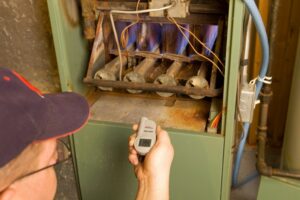Gas furnaces are designed with safety as a top priority. As long as you schedule regular furnace service in Haughton, LA each year to have your gas furnace inspected and maintained, there’s very little chance that the furnace will develop any hazardous malfunctions. You can enjoy many years of cozy warmth in your home without concern about the safety of the furnace.
However, it pays to know a bit more about the ways a furnace might develop unsafe operation. The most common concern is a cracked heat exchanger, which may occur in an older furnace or one that hasn’t received regular maintenance. We’ll explain this situation in detail below.
The heat exchanger
The heat exchanger is the part of a gas furnace that directly heats the air heading into the ventilation system. It’s a metal chamber that collects the hot combustion gas from the burners when the furnace is running. The gas heats the metal, and the surface of the metal heats the air the blower pushes through the furnace. Once the heat cycle is completed, the cooled combustion gases still inside the heat exchanger escape through a flue and out of the house. The heat exchanger thus allows the gas jets to heat the air in the house without harmful combustion gases coming into direct contact with that air.
The danger of cracks
From this description, you may already have an idea why cracks in a heat exchanger aren’t good news. When the heat exchanger heats up from the combustion gases, the metal expands. Even a small crack on the exchanger can open wide enough that it will allow the gases inside to escape and enter the air blown into the house. These gases include carbon monoxide, which is colorless, odorless, tasteless, and highly toxic.
How cracks form on the heat exchanger
Cracks are most likely to appear on a heat exchanger in an older furnace. The years of metal expanding and contracting can create enough stress to cause cracks. This is one of the reasons we recommend replacing a furnace that’s more than 15 years old—this is the point where it’s at a greater danger of cracks.
Corrosion is another major source of cracks in a heat exchanger. The reaction between the leftover combustion vapor with metal can create corrosion over time, especially if the furnace isn’t venting properly because of lack of maintenance or repair. Corrosion weakens the metal and makes it much easier for cracks to form as the metal expands.
Dealing with a cracked heat exchanger
The best way to deal with cracks in a heat exchanger is to have regular maintenance for your gas furnace every year. During maintenance, our Moon’s Air technicians carefully inspect the heat exchanger to find if it’s developing corrosion or if there are cracks forming. Repairing the problem requires replacing the heat exchanger. In an older furnace, it’s often more cost-effective to have the entire furnace replaced. Our experts will help you discover the best option for your home’s comfort and safety.
Moon’s Air has provided whole-home comfort since 1971. Call us for service today—it’s good to be Mooned!










